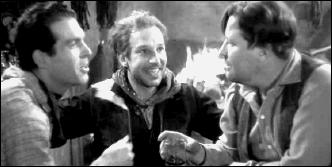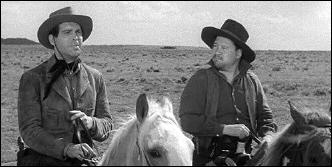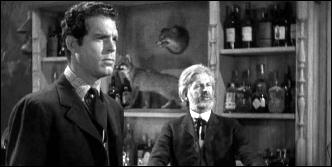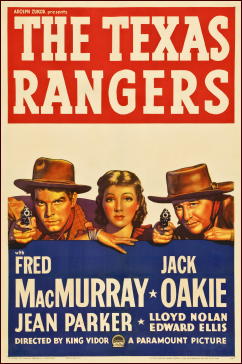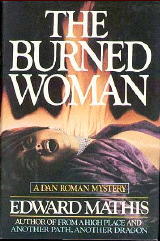Reviewed by DAVID VINEYARD:
THE FUGITIVE. RKO Radio Pictures, 1947. Henry Fonda, Dolores Del Rio, Ward Bond, Pedro Armendariz, J. Carroll Naish, John Qualen, Fortuno Bonanova, Rodolfo Acosta. Screenplay by Dudley Nichols, based on the novel The Power and the Glory by Graham Greene. Directors: John Ford and Emilio Fernandez, the latter uncredited.

Asked by a journalist to name the top three American film directors of all time, Orson Welles replied honestly: “John Ford, John Ford, and John Ford.â€
Certainly Welles was being clever, but he was also being honest. When it comes to film directors, there is John Ford and then there is everyone else.
I will be clear. I would reply to this day exactly as Welles did, though I would add the finest film director who has lived to this date.
So take this project, The Fugitive, the film version of Graham Greene’s stunning novel of faith, guilt, and redemption, The Power and the Glory, only surpassed in his own work by The Burnt Out Case, his finest achievement as a serious novelist. Add to that a screenplay by the brilliant Dudley Nichols, and topped with a cast of Ford’s favorite everyman Henry Fonda, and what you have is …
A misfire.
A misfire, because you could not find two men more diametrically opposed in outlook, philosophy, and their shared Catholic faith than John Ford and Graham Greene. Ford’s film adaptation is faithful and direct, often straight from the novel. But where Greene wrote his novel as a deeply conflicted Catholic uneasy with his faith and all too aware of the futility of his heroes victory, John Ford made a movie about the Christ-like sacrifice of a flawed priest and the ultimate triumph of the church through the ascension and symbolic resurrection of his hero.

It’s the exact same story, save Greene’s novel is one of the closest he came to writing a tragedy, Ford’s is a sentimental and triumphant parable about the redemption of the faithful in Mexico through the sacrifice of a flawed man rising to ascension in the footsteps of Jesus.
The story is simple. In the 1930‘s parts of Mexico were under the control of a secular anti-Catholic, anti-faith, near police state where there was a bounty on the head of any priest ministering to the people. The Catholic Church responded by sending priests in lay disguise into the country to attend to the religious needs of the faithful from last rites to confession. The hero of Greene’s novel is one of these, a Mexican priest returned to serve his flock.

Here Ford and Greene hove close to each other. The young priest (Henry Fonda) is what was known then as a ‘whiskey’ priest, one who had failed in his duties, fallen into sin, and in this case even had an affair with a Mexican woman, Dolores del Rio. On the ship entering Mexico with the priest is an American bank robber (Ward Bond) who will play the good thief to the priest’s Jesus, also true to the novel.
Meanwhile a lieutenant in the Federales, Pedro Armendariz, knows a priest has entered his territory and is determined to find and execute him.
Greene’s hero, is frightened, uncertain of his mission, tempted by drink and sex, and struggles with his faith in lieu of the pressure on him from all sides to turn back and abandon this suicide mission. Ford’s priest is seeking redemption, is near Christlike in his determination to repent for his sins, and finds peace in his mission and ultimate fate.
Greene’s novel is never sentimental and only symbolic in its questioning: an allegory of fragile men battling intolerance and evil, but flawed and weak and ultimately all too human. Though Greene’s hero meets the exact same fate in front of a firing squad after being betrayed by metizo J. Carroll Naish, a whining slimy treacherous Judas figure, his death in the novel redeems no one, not even himself.

Ford’s film, though is full of beautiful Christian imagery borrowed from the great works of religious art from Michelangelo and Leonardo to Rembrandt. Shot in stark black and white on location in Mexico, it is a stunning looking film as you might expect from Ford. Ford’s priest dies as triumphal as the risen Christ with the Lieutenant’s Pontius Pilate unable to wash the innocents blood from his hands. In the novel the Lieutenant at best feels a certain guilt at having killed the priest, and questions his work.
Nothing demonstrates the difference between film and book as the ending does, though it is almost word for word the same in both. After the whiskey priest dies, a Catholic family silently mourns him and waits for a relative to die without the last rites. There is a knock at the door and a child goes to open it. A man stands in the doorway and begins to announce he is a priest, but before he can speak the child silences him with a finger to his lip, and he enters the darkened home.

In Greene’s version we are meant to recognize the futility of the priest’s sacrifice. However noble it was, the Church would always send another man because the Church transcended individual sacrifice. In a sense Greene’s hero has saved no one’s soul but his own and maybe the thief’s. He accomplished little, died for his efforts, but was only a cog in the machinery of faith. His sacrifice was an illusion that has meant nothing to anyone but himself and will be forgotten by everyone but a handful of people, lost even as his body lies in unconsecrated ground no last rites read over it to ease his soul heavenward.
The book is not tragic because he does overcome his flaws, but just how necessary that sacrifice was is questioned. It is the work of a deeply faithful and conflicted Catholic, himself held captive by guilt and self recognition. The novel is a deep and troubling question about the necessity of sacrifice and the blindness of faith.

That same scene in the Ford film is triumph, the rising of Christ Himself, reborn in this new anonymous priest. The Church has defeated the forces repressing it. The priest has defeated his enemy’s in death and his own inner demons, their power is broken, the faithful have triumphed, the music rises, the priest silhouetted in the door way is Christ, the child mankind saved by his Grace.
Ford’s film is sentimental, worshipful, a paean to the power and glory of the Church, and yet the title of the novel, The Power and the Glory, is ironic and the Church would have triumphed and continued with or without the priest’s sacrifice. The film is heavy handed, it’s message delivered with a sledge hammer of symbolic images and barely concealed metaphors. A revival would be less obvious.
The novel leaves questions unanswered, the ending is ironic and a bit bitter, the priest’s sacrifice of little matter however Christ-like its nature. Greene is uncertain if it is necessary or pointless for a good man to die. Good Catholic that he was, Greene is clearly wishing he could change the outcome and let the priest find happiness with the woman. The author’s conflict, not the parable. make this a great book.

The Fugitive is not a bad film. Like most Ford films, it is gorgeous to look at, literate, and the acting by Fonda, del Rio, Bond, Armedariz, and Naish well above average. It would likely be a more respected film if it had just had the courage to question faith and sacrifice as Greene’s novel did. Instead it is as sentimental about the faith as Going My Way or Boys Town.
The power of the novel is lost in Christian symbolism, the glory of its telling sacrificed to just another heavy handed Hollywood religious parable about as subtle, but not half as much fun, as de Mille.
Greene famously disliked the film, with some justification, both as the author and as a noted film critic, but then he was never very happy with any of the American films of his work, and expecting him to appreciate one by the sentimental Irish American patriot John Ford was probably too much to ask.
The Power and the Glory did get a more faithful adaptation in a film made for British television and released theatrically, starring Lawrence Oliver as the whiskey priest and Claire Bloom the woman he loves. This version dares to ask the questions and pose the conundrums Ford’s film shies from. It may be the only time in history the made for television version was better than the theatrically released feature. It is certainly one of the few times anyone made a better film than John Ford using the same source.
